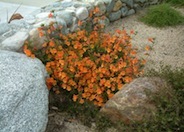
Common name:Blue Beach Aster, Seaside Daisy
Botanical name:Erigeron glaucus
This perennial will grow 1' tall and 1.5' wide. It has blue/green foliage and lavender flowers that bloom in spring and summer.

Common name:Arctotis Daisy, African Daisy
Botanical name:Arctotis hybrids
African Daisy hybrids grow 12-18" high x 12" wide and produce daisy-like flowers from spring through summer. These hybrids have lobed leaves and bloom in whtie, pink, red, purple, cream and orange. For trailing African Daisies, see Osteospermum fruticosum, or 'Freeway Daisy'.
Ericameria linearifolia

Common name:Blue Eyed Grass
Botanical name:Sisyrinchium bellum
Following winter rains, this grassy perennial brings a soft texture back into the garden. It produces an abundance of small blue-purple flowers which have a long bloom.

Common name:Catmint
Botanical name:Nepeta X faassenii
Nepeta faassenii makes soft, gray-green, undulating mounds o 1.5 ft. high in bloom. The small leaves are attractive to cats. This perennial has lavender blue flowers in late spring, and early summer.

Common name:Pumpkin Monkey Flower
Botanical name:Mimulus 'Pumpkin'
Mimulus 'Pumpkin' is one of the best performing and 'garden tolerant' of the dry Mimulus species/hybrids. Although it still requires well drained soil and drier conditions, in most environments it stays evergreen and can bloom through the year with supplemental summer water when other varieties will die. Reaches 18-24"H x 18-24"W and blooms profusely with two toned pumpkin orange flowers. Truly stunning and effective in the garden, especially in mass.

Common name:Sea Pink, Common Thrift
Botanical name:Armeria maritima
This clumping, grass-like perennial is native to many areas, including coastal California. Its flowers range from deep rose pink through white. -Monterey Bay Nursery
Sustainable landscaping is a term coined to mean sensible landscape practices that work within the limits of the Eco-system. This means within the limits of your local rainfall, soil conditions and sun patterns.
Click in the green box for more information
Designer: Nancy Niemeyer
Photographer: GardenSoft
Maintain a two to four inch layer of mulch on the soil surface to reduce weeds, infiltrate rain water, and reduce compaction.
Mulching and adding compost to soil can minimize evaporation and help soil absorb and store water.
Attract, or buy beneficial insects such as ladybugs and lacewings to control pest outbreaks in your garden.